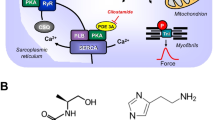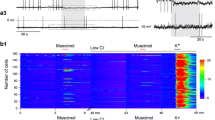Abstract
The nature of the histamine receptor mediating inhibition of 5-HT release was investigated in strips of the porcine small intestine by investigating the effects of histamine ligands on the overflow of endogenous 5-HT and its metabolite 5-hydroxyindoleacetic acid (5-HIAA). The overflow was measured by HPLC, combined with electrochemical detection and represents calcium-sensitive 5-HT release from enterochromaffin cells, as reported previously. The histamine H3 receptor selective agonists (R)-α-methyl-histamine and imetit inhibited the overflow of 5-HT maximally by 50–60%, with EC50 values of 48 and 3.2 nmol/l, respectively. Effects on 5-HT overflow were always accompanied by similar effects on the overflow of 5-HIAA. Thioperamide (100 nmol/l) shifted the concentration response curve of (R)-α-methyl-histamine to the right (pKB value 8.38). The inhibitory effect of 1 μmol/l (R)-α-methyl-histamine was antagonized in a concentration-dependent manner by thioperamide (IC50: 65 nmol/l) and dimaprit (IC50: 8.6 μmol/l); however, the effect of (R)-α-methyl-histamine was weakly antagonized by burimamide (by 38% at 100 μmol/l) and not significantly affected by other H3 receptor antagonists, such as impromidine, betahistine and phenylbutanoyl-histamine (each up to 100 μmol/l). In conclusion, H3 receptors mediating inhibition of 5-HT release from porcine enterochromaffin cells have a particular pharmacological profile indicating that heterogeneity of H3 receptors may exist. The data suggest that histamine H3 receptors modulating 5-HT release in pig small intestine do not belong to either H3A or H3B receptors as defined in rat tissue.
Similar content being viewed by others
References
Arrang JM, Garbarg M, Quach TJ, Dam Trung Tuong T, Vermian E, Schwartz JC (1985) Actions of betahistine at histamine receptors in the brain. Eur J Pharmacol 111:73–84
Arrang JM, Garbarg M, Lancelot JC, Lecomte JM, Polloard H, Robba M, Schunack W, Schwartz JC (1987) Highly potent and selective ligands for histamine H3 receptors. Nature 327:117–123
Clapham J, Kilpatrick GJ (1992) Histamine H3 receptors modulate the release of [3H]-acetylcholine from slices of rat entorhinal cortex: evidence for the possible existence of H3 receptor subtypes. Br J Pharmacol 107:919–923
Furchgott RF (1972) The classification of adrenoceptors (adrenergic receptors). An evaluation from the standpoint of receptor theory. In: Blaschko H, Muscholl E (eds) Handbook Exp Pharmacol, vol 33. Springer, Berlin Heidelberg New York, pp 283–335
Garbarg M, Arrang JM, Rouleau A, Ligeau X, Dam Trung Tuong M, Schwartz JC, Ganellin CR (1992) S-[2-(4-imidazolyl)ethyl]isothiourea, a highly specific and potent histamine H3 receptor agonist. J Pharmacol Exp Ther 263:304–310
Hill SJ (1990) Distribution, properties, and functional characteristics of three classes of histamine receptors. Pharmacol Rev 42:45–83
Howson W, Parsons ME, Raval P, Swayne GTG (1992) Two novel, potent and selective histamine H3 receptor agonists. Bioorg Med Chem Lett 2:77–78
Kilpatrick GJ, Michel AD (1991) Characterization of the binding of the histamine H3 receptor agonist [3H]-(R)-alpha-methyl histamine to homogenates of rat and guinea-pig cortex. Agents Actions 33:69–75
Racké K, Schworer H (1991) Regulation of serotonin release from the intestinal mucosa. Pharmacol Res 21:13–25
Racké K, Schwörer H (1992a) Nicotinic and muscarinic modulation of 5-hydroxytryptamine (5-HT) release from porcine and canine small intestine. Clin Invest 70:190–200
Racké K, Schwörer H (1992b) Differential role of calcium and sodium channels in the stimulus secretion coupling of 5-hydroxytryptamine release from porcine enterochromaffin cells. Naunyn Schmiedeberg's Arch Pharmacol 347:1–8
Racké K, Schwörer H (1992c) Novel histamine H3 receptor subtype (H3C) mediates inhibition of 5-hydroxytryptamine release from porcine enterochromaffin cells. Naunyn Schmiedeberg's Arch Pharmacol 346:R2
Rangachari PK (1992) Histamine: mercurial messenger in the gut. Am J Physiol 262:G1–G13
Schlicker E, Behling A, Lümmen G, Göthert M (1992) Histamine H3A receptor-mediated inhibition of noradrenaline release in the mouse brain cortex. Naunyn-Schmiedeberg's Arch Pharmacol 345:489–493
Schwörer H, Racké K, Kilbinger H (1987) Spontaneous release of endogenous 5-hydroxytryptamine and 5-hydroxyindoleacetic acid from the isolated vascularly perfused ileum of the guinea-pig. Neuroscience 21:297–303
Schwörer H, Katsoulis S, Racké K (1992) Histamine inhibits 5-hydroxytryptamine release from the porcine small intestine. Involvement of H3 receptors. Gastroenterology 102:1906–1912
Soldani G, Mengozzi G, Intorre L, De Giorgi G, Coruzzi G, Bertaccini G (1993) Histamine H3 receptor-mediated inhibition of gastric acid secretion in conscious dogs. Naunyn-Schmiedeberg's Arch Pharmacol 347:61–65
Tallarida RJ, Murray RB (1988) Manual of pharmacological calculations. Springer, Berlin Heidelberg New York
Taylor SJ, Kilpatrick GJ (1992) Characterization of histamine-H3 receptors controlling non-adrenergic non-cholinergic contraction of the guinea-pig isolated ileum. Br J Pharmacol 105:667–674
Timmerman H (1990) Histamine H3 ligands: Just pharmacological tools or potential therapeutic agents? J Med Chem 33:4–11
Van der Werf JF, Timmerman H (1989) The histamine H3 receptor: a general presynaptic histaminergic regulatory system? Trends Pharmacol Sci 10:159–162
Wallenstein S, Zucker CL, Fleiss JL (1980) Some statistical methods useful in circulation research. Circ Res 4:71–79
West RE Jr, Zweig A, Shin NY, Siegel MI, Egan RW Clark MA (1990) Identification of two H3-histamine receptor subtypes. Mol Pharmacol 38:610–613
Author information
Authors and Affiliations
Additional information
Correspondence to: K. Racke at the above address
Rights and permissions
About this article
Cite this article
Schwörer, H., Reimann, A., Ramadori, G. et al. Characterization of histamine H3 receptors inhibiting 5-HT release from porcine enterochromaffin cells: Further evidence for H3 receptor heterogeneity. Naunyn-Schmiedeberg's Arch Pharmacol 350, 375–379 (1994). https://doi.org/10.1007/BF00178954
Received:
Accepted:
Issue Date:
DOI: https://doi.org/10.1007/BF00178954




